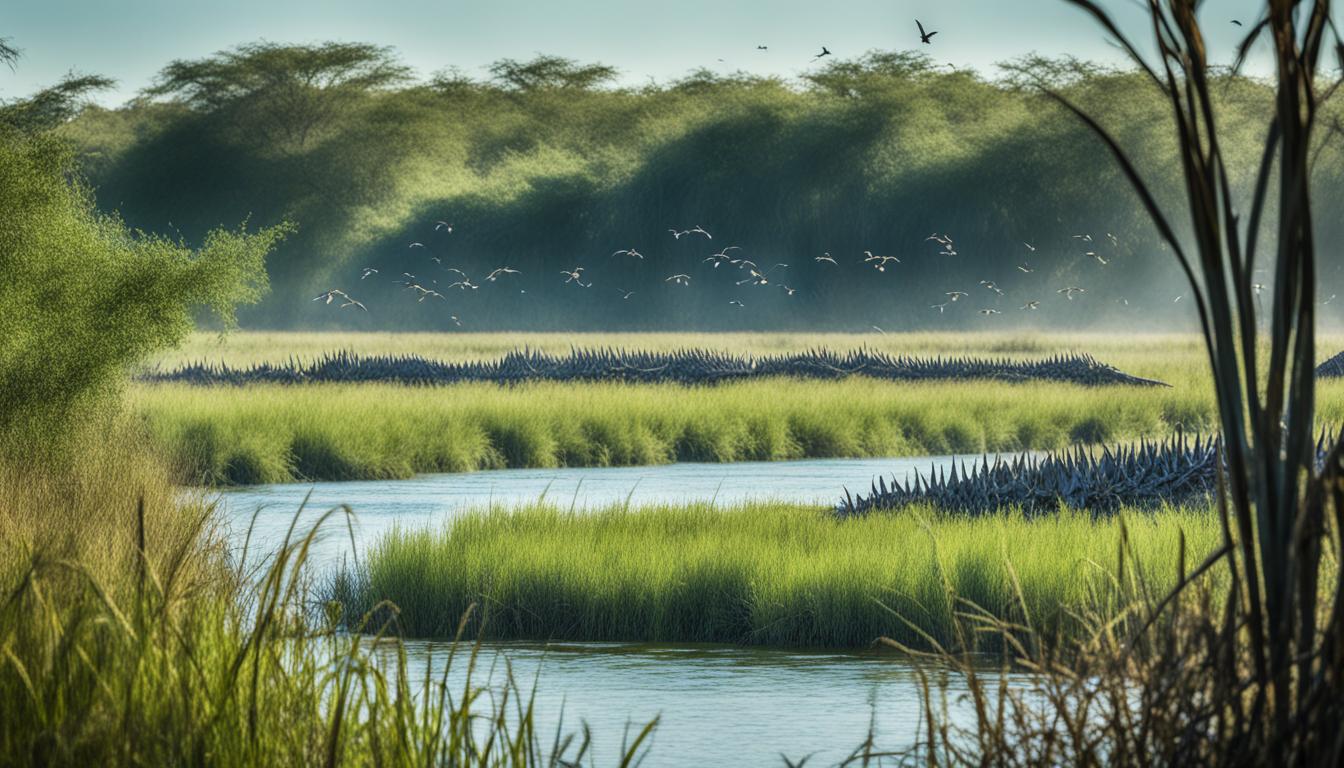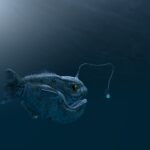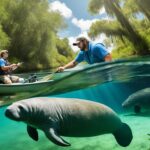Crocodile hunting is a fascinating topic that shows how these predators are incredibly adaptable and skilled. You will learn about the tactics crocodiles use to hunt and how they do it so well. They use their smart thinking, work together, and sneak up on their prey. This makes their hunting methods interesting to understand.
We will also look into their feeding habits. This will help us see how crocodiles fit into their ecosystems.
Let’s explore the world of crocodile hunting together. We’ll see the strategies they use to be such effective hunters in nature.
The Intelligence Behind Crocodile Hunting
Crocodiles are often seen as simple creatures, but they are smarter than people think. Recent studies show they have complex thinking skills. These skills help them survive and hunt better.
Crocodiles’ Cognitive Abilities
Looking into crocodile intelligence helps us understand how they hunt. They show advanced parental care, communicate well, and even use tools. This shows they have strong planning and problem-solving skills. These abilities make them smart hunters.
Social Structure and Cooperation
The way crocodiles live together affects their hunting. They often hunt in groups, showing teamwork. Big ones push prey into shallower water for others to ambush. This teamwork shows their smarts and how they adapt to their hunting spots.
Young crocodiles learn from the older ones, getting better at hunting over time. This learning shows how smart and adaptable they are.
Understanding Crocodile Hunting Behaviour
Crocodiles have amazing hunting ways that show how they survive. One key method is crocodile ambush hunting. This method uses stealth and patience to catch prey off guard.
Ambush Hunting Techniques
Ambush is key in crocodile hunting. They stay still and blend in with their surroundings. By hiding in the water, they wait for animals to get too close.
This works best at night when it’s hard to see. They can stay still for a long time, making them great hunters.
Feeding Patterns and Habits
Crocodiles eat based on what’s available in their home. They can go without food for a long time because they have slow metabolisms. This suits them for places where food is scarce.
They mostly eat fish, birds, and mammals near water. The availability of food changes with the seasons and water levels. This affects their eating habits.
How Do Crocodiles Hunt?
Crocodiles use advanced hunting techniques that show their skill in strategy, stealth, and ambush. These tactics help us understand their hunting behavior and appreciate their amazing abilities.
Hunting Strategies Explored
Crocodiles have many hunting strategies, depending on where they live. They often wait patiently and strike at the right time to catch their prey. Here are some common methods they use:
- Staying motionless: They lie still and blend in with their surroundings to avoid being seen.
- Quick lunges: When they see an opportunity, they move fast to catch their prey off guard.
- Choosing the right location: They pick spots that give them the best chance of catching prey.
Use of Stealth and Ambush
Stealth is key to a crocodile’s hunting success. They hide in murky water and thick vegetation to sneak up on their prey. Their sharp senses help them detect movement in and out of the water. This skill lets them:
- Conserve energy: They stay still for a long time to save energy before making a quick attack.
- Blindside their victims: Their stealth lets them surprise their prey with a sudden attack.
- Adapt to different environments: They adjust their hunting based on the landscape and the animals they hunt.
Crocodile Hunting Adaptations
Crocodiles have many adaptations that help them hunt well. These traits are key to their survival. They have both physical and behavioral features that make them great hunters. Let’s look at the main ways these reptiles are built for hunting.
Physical Adaptations for Hunting
The physical traits of crocodiles are amazing and crucial for their hunting. Key features include:
- Powerful jaws: Their jaws are strong, letting them grip and crush their prey.
- Sharp teeth: These teeth help them hold onto slippery animals, making sure they don’t get away.
- Strong tails: Their tails help them move fast, which is important for chasing prey.
- Streamlined bodies: Their bodies are shaped for swimming and quick underwater movements.
- Strategically placed eyes: Their eyes are on top of their heads. This lets them see above water without being seen.
Behavioral Adaptations Supporting Prey Capture
Crocodile behavior plays a big part in their hunting. These behaviors show how smart and flexible they are at catching prey. Notable behaviors include:
- Patience and stealth: They often wait quietly for a long time, using stealth to sneak up on prey.
- Tool use: Some use sticks or other objects to lure birds and fish, showing they can solve problems.
- Adaptive strategies: They change how they hunt based on the prey, showing they can adapt.
- Social hunting behaviors: Sometimes, they hunt together, which helps them catch more prey.

Crocodile Prey Selection
Crocodiles are fascinating predators, known for their clever hunting ways. They pick their prey based on what they need to survive in different places. Their choices depend on what they like to eat and where they hunt.
Dietary Preferences and Hunting Locations
Crocodiles eat mainly what they can find in their homes. They mostly eat:
- Fish
- Birds
- Mammals
They hunt in places like rivers, swamps, and lakes. These spots have lots of fish, perfect for their meals. Sometimes, they even eat land animals that come to drink near the water.
Impact of Environment on Prey Availability
The environment affects how well crocodiles find food. Weather changes can make it harder or easier to find food. For example, drought lowers water levels and fish numbers. But, rain can bring more food but also make hunting tough because of floods.
Crocodiles change their hunting ways to stay successful, no matter the weather.
Crocodile Hunting Techniques in Teams
Crocodiles show amazing teamwork when hunting. They work together, using strategies that make them a strong team. This teamwork helps them catch prey more effectively.
Coordinated Hunting Behaviour
When hunting, crocodiles place themselves in the best spots to catch fish. They push fish together, making it easier for each crocodile to grab one. This shows how well they work together, surprising those who thought they hunted alone.
Roles Within a Hunting Group
In a hunting group, crocodiles have different jobs based on their size. Bigger ones do different things than the smaller ones:
| Role | Size | Function |
|---|---|---|
| Driver | Larger | Corral prey into shallow water |
| Snatcher | Smaller | Quickly capture prey |
This division of roles creates a dynamic hunting scene. It’s similar to how wolves or lions hunt together. This teamwork gives them a big advantage in catching prey.
Crocodile Predator-Prey Interactions
Crocodiles are key predators in their ecosystems. They play a big role in keeping wildlife populations in check. Their actions affect how other animals behave and move, keeping the ecosystem balanced.
This balance is crucial for the health of the environment. By controlling populations, crocodiles prevent some species from taking over. This helps maintain the natural order of things.
It’s important to understand how crocodiles interact with their prey. These predators use smart hunting strategies. This affects not just the prey but also the whole habitat.
When crocodiles remove certain prey, it can change the balance. This shows how connected the food web is. It also shows why crocodiles are important for biodiversity.
The relationship between crocodiles and their prey shows nature’s fine balance. Each encounter is part of a complex survival dance. Crocodiles, with their hunting skills and ecological role, show how predator-prey interactions keep environments healthy.
FAQ
How do crocodiles hunt their prey?
Crocodiles hunt by using ambush tactics. They wait patiently for prey to come close. They use their stealth, camouflage, and sharp senses to spot movements. Then, they attack quickly.
What cognitive abilities do crocodiles have?
Studies show that crocodiles are smarter than we thought. They have complex social behaviors, take good care of their young, and use tools for hunting. This shows they are very intelligent.
What hunting strategies do crocodiles use?
Crocodiles hunt in different ways. They move quietly, set up in the best spots, and sometimes hunt together. This teamwork helps them catch prey more often.
How do environmental factors influence crocodile hunting?
The environment affects how many prey crocodiles find. Changes in seasons can change how many animals there are. This changes where crocodiles hunt and what they eat.
What types of prey do crocodiles typically target?
Crocodiles eat a variety of things. They like fish, birds, and mammals that live near water. They also eat carrion if they can’t find other food.
How do crocodiles demonstrate teamwork during hunting?
Crocodiles hunt together, working as a team. They herd fish into a small area. Then, each one takes a turn catching some, showing how smart they are together.
What physical adaptations help crocodiles in hunting?
Crocodiles have strong jaws and sharp teeth for catching prey. They are built for swimming fast and have eyes on top of their heads. This lets them see above water without being seen.
How do behavioral adaptations enhance crocodile hunting success?
Crocodiles are patient and use tools to catch prey. They change their hunting based on the prey and their surroundings. These behaviors help them hunt better, showing how smart and adaptable they are.
In what ways do crocodile hunting techniques impact their ecosystems?
As top predators, crocodiles are key to their ecosystems. They control prey numbers and keep the environment balanced. Their hunting changes how prey animals behave, helping to keep the ecosystem diverse.







